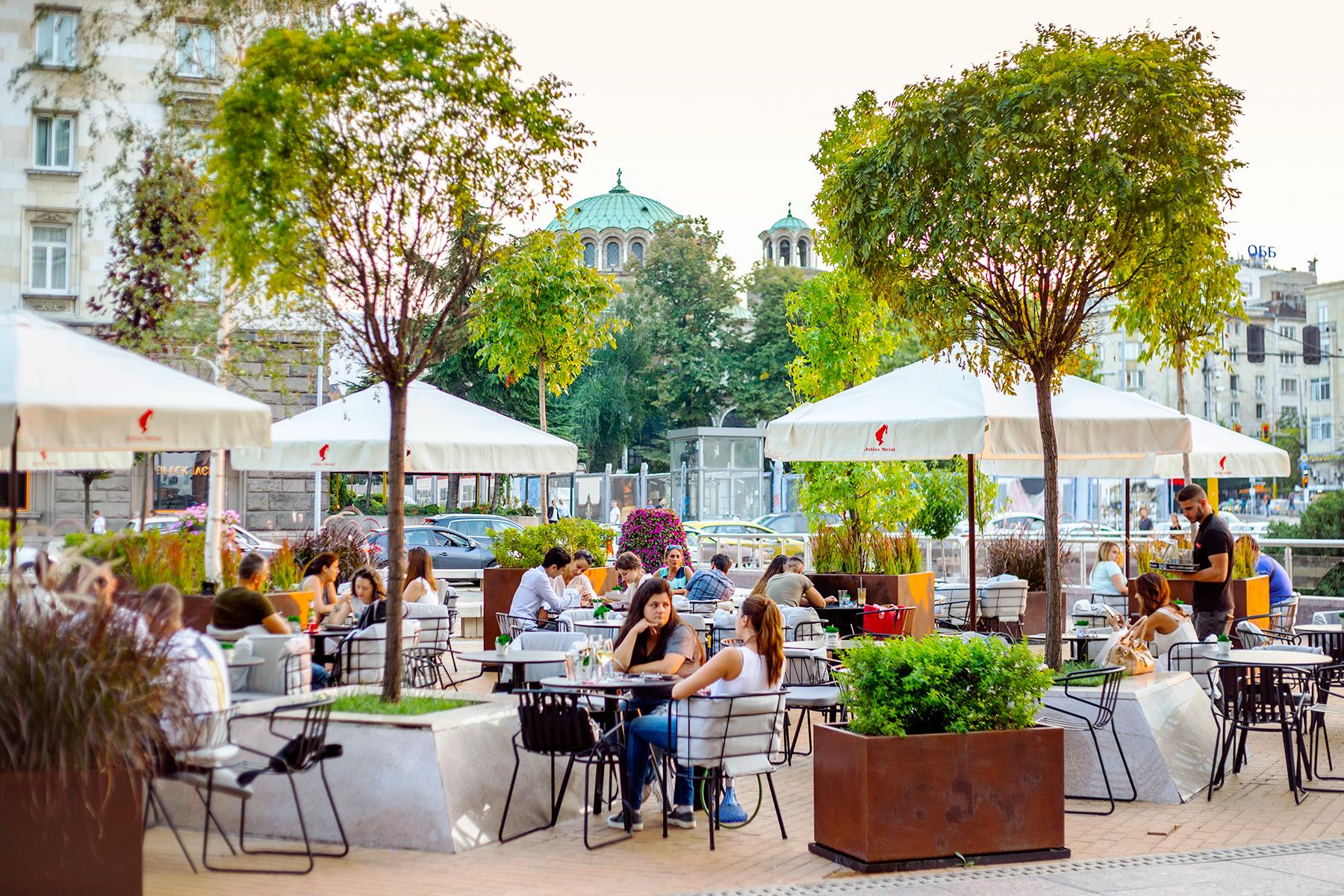Breakfast is the most important meal of the day all over the world, but few countries indulge in more lavish dishes than the early risers of Bulgaria.
In Bulgarian homes, breakfast tables are rarely cleared of jars of jam, bowls of chutney, and other breakfast-related items. Most Bulgarian breakfast foods are hearty and high in fat, intended to sustain you well through dinnertime, with only a light salad eaten for lunch if necessary. From delicately layered cheesy pastries to meaty open-faced sandwiches broiled to perfection, here are the most delicious—and decadent—Bulgarian breakfast foods to try while in Sofia.
Top Picks for You
Banitsa
If you can only try one breakfast food while in Bulgaria, make sure it’s banitsa. This savory pastry is eaten either hot or cold for breakfast, but it also makes a great snack any time throughout the day. Layers of Bulgarian cheese (similar to a whipped feta), eggs, and yogurt are wrapped tightly into sheets of paper-thin filo dough before getting spiraled around a circular pan and baked in the oven until crispy. The spherical pie is served by the slice either with a dollop of fresh yogurt or a drizzle of honey. Hle Bar makes their banitsa in individual cylindrical tubes that make them portable for grabbing a quick breakfast on the go.
Boza
This fermented wheat beverage is all at once loved by locals and loathed by tourists for its sweet, sour, and yeasty flavor combination. Similar to coffee, boza is a staple for breakfast, often served with banitsa, as it delivers a healthy punch of vitamins and iron. Bulgarian legend praises the drink as having breast augmentation qualities, but recent studies have proven that any expanded chests that come from drinking this low-alcohol (less than 0.5 percent) and highly caloric drink likely come paired with expanded waistlines as well. The best versions are organic and made with real sugar, like the one served at Furna off Stefan Stambolov Boulevard in Sofia.
Related: Fodor’s Sofia Guide
INSIDER TIPMake sure your boza comes straight from the fridge if it’s your first time ordering a cup, as warmer versions tend to be fizzier and are often harder to digest for first-timers.
Recommended Fodor’s Video
Popara
The Balkan cousin of bread pudding, popara is often referred to as a porridge for its dense, hot, and creamy texture. Bulgarian children prefer the dish to cereal in the morning, where warm milk, cubed bread, Bulgarian cheese (similar to feta), butter, and sugar blend together to create a salty, sweet, and totally satisfying meal. It may not be the most Instagram-worthy breakfast in the country, but you’d be hard pressed to find a Bulgarian who doesn’t have a soft spot in their heart for this sloppy dish. Grab a piping hot bowl of authentic popara at Fabrika Daga (Rainbow Factory).
INSIDER TIPFabrika Daga (Rainbow Factory) serves an international menu throughout the week, with many Bulgarian dishes on the menu, but on weekends they offer a Bulgarian Rustic Breakfast that features many of the most traditional and beloved recipes from the country.
Mekitsa
Although you’re bound to find some Bulgarians eating his or her mekitsa plain, the real fun of these fried pastries is found in the toppings. Often called “Bulgarian donuts,” mekitsa are round and flat, made with a dough of flour, eggs, yogurt, water, yeast, salt, and oil. Each piece is deep-fried until golden brown, and then receives a generous topping of powdered sugar, jam, cheese, Nutella, fruit, and/or honey. The name is derived from the Bulgarian word for soft (“mek”) and the pastries are often eaten by folding the mekitsa in half and digging in taco-style. Arguably the best mekitsa can be found in Sofia at Mekitsa and Kafe.
Princesses
This open-faced breakfast sandwich is made with a mixture of minced meat and baked cheese blended together with a whisked egg and baked until the mixture bubbles on top of a thick slice of fresh bread. Only a handful of bakeries and cafes sell this rustic dish, but Café Atlas serves a number of traditional recipes, including the best Princess in the city, where toppings are as thick as the slice of bread on which they’re spread.
Ayran
Prized as the Bulgarian hangover cure, this chilled drink is made by blending together equal parts water and yogurt with a pinch of salt. Locals often add herbs like mint to add some color and texture, but it’s always accompanied by a slice of Bulgarian banitsa. The drink is served in most restaurants, and a bottled version can be found even in most convenience stores, but the homemade version at Daro Café is made fresh and pairs perfectly with the café’s delicious pastries.
Parjeni Filiiki
Similar to French toast, this classic Bulgarian dish is a favorite for weekend breakfasts. Thick slices of freshly baked bread are dipped in a batter of eggs, flour, and milk before getting pan fried on each side until golden. Unlike its French cousin, parnjeni filiiki is never drenched in syrup but is instead served with a square of fresh cheese or topped with berries or homemade jam. Many restaurants will serve these fried toasts with a drizzle of honey or a sprinkle of powdered sugar if requested, but the crispy and fluffy version Raketa Rakia Bar makes are best enjoyed salty with only a topping of crumbled Bulgarian sirene (a cheese similar to feta).
Lukanka
Although you may find lukanka on the table during lunch or dinner, this hard salami always has a home in a Bulgarian breakfast spread. The taste is almost similar to an Italian sopresatta, where spicy notes of black pepper and cumin round out this oval-shaped sausage. Traditional recipes are aged in a windy location for a minimum of two months, but some versions are aged for up to a full year. Find them on a breakfast table served sliced as an appetizer or diced into banitsa or crepes with chunks of fresh white cheese. Hadjidraganovite izbi offers lukanka on their menu all day.
Rodopski Kolatsi
These pancake-like treats were traditionally made in the Rhodope Mountains to mark the beginning of the winter holidays, but now they’re served all-year-long throughout Bulgaria. Rodopski Kolatsi are made from a batter of yogurt, eggs, baking soda, flour, and a little salt and sugar (some recipes use yeast). Similar to traditional pancakes, hearty scoops of this batter are grilled on a skillet until golden brown on each side, but unlike sugar-sopped pancakes, these cakes are typically served without syrup, instead coming with a side of jam, honey, and sirene (a fresh Bulgarian cheese similar to feta). Cakey Bakey is one of Sofia’s most popular spots for indulging in this Rhodope recipe.
Lyutenitsa
Call it a paste, chutney, or relish, but no matter which name you prefer, you’re sure to find a jar or bowl filled with this spicy accouterment on every breakfast table around Bulgaria. Lyutenitsa (or ljutenica or lutenica) is a mashed up blend of tomatoes, garlic, salt, eggplant, and spicy peppers. Every home and every restaurant will have their own variation (some like carrots, while others prefer parsley), but most will at least appear similar, with a red tint and a smooth consistency with chunks of eggplant or tomato bits giving the spread a delicious texture. Lyutenitsa is served on the tables at Divaka and Chevermeto for breakfast, to be eaten as a spread on toast or banitsa, or as a dip for different kinds of meat.
Kozunak
This brioche-like bread is pillowy-soft and lightly sweet, with a slight crunch from the sugar-crusted coating the bread is given right before it enters the oven. Kozunak is a traditional Bulgarian recipe that is often made during Easter. Rum-soaked raisins, zest from a fresh lemon, and tiny brown specs of vanilla bean give this bread its signature flavor. Although it’s typically eaten for breakfast during Easter throughout the country, it’s baked all year round at JoVan Bakery in Sofia.
Biskvitena Torta
Cake? For breakfast? It’s the Bulgarian way. Biskvitena Torta, or biscuit cake is a no-bake cake that consists of layers of malted milk biscuits, Bavarian cream, cocoa powder, and chocolate shavings. Home bakers typically make this decadent dessert in the summer, when it’s too hot to turn on the oven, but Bar White serves an amazing version of this creamy cake throughout the winter as well.





